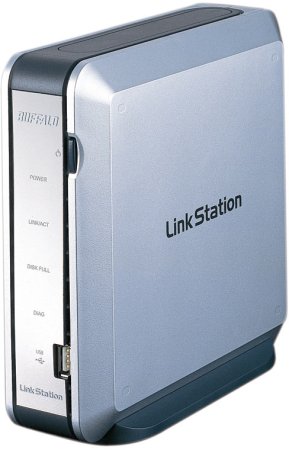Device Profile: Buffalo LinkStation NAS
Jan 13, 2006 — by LinuxDevices Staff — from the LinuxDevices Archive — 8 views Buffalo Technology used embedded Linux to build a compact NAS (network attached storage) device with a capacity of 160 to 450 gigabytes. The LinkStation Home Server features gigabit Ethernet connectivity and the capability of streaming multimedia content to media players that comply with DLNA specifications.
Buffalo Technology used embedded Linux to build a compact NAS (network attached storage) device with a capacity of 160 to 450 gigabytes. The LinkStation Home Server features gigabit Ethernet connectivity and the capability of streaming multimedia content to media players that comply with DLNA specifications.

Buffalo's LinkStation is a small, single-drive NAS server
(Click to enlarge)
Buffalo is a Japan-based consumer electronics company whose products have long been available online through sellers such as TigerDirect, NewEgg, mWave, and many others. However, the company's Linux-based NAS devices and media adapters have also started to win placement in US retail stores, such as Staples.
What's under the hood?
The LinkStation is based on a PowerPC processor clocked at 266MHz. It boots Linux from a 128MB partition on its internal harddrive. It has 128MB of RAM, and a 128MB swap partition.
Along with a gigabit Ethernet port, the LinkStation offers dual USB 2.0 ports, which can be used to attach a printer or an external hard drive, Buffalo says.
According to Brian Verenkoff, product manager, Buffalo's Japan-based engineering team handled the Linux port and filesystem implementation in-house. Like Buffalo's TeraStation HS, the LinkStation uses a Media Server software stack from MediaBolic.
According to Verenkoff, Buffalo chose Linux because it can be freely modified to meet requirements, and because it requires no licensing fees. “With no licensing fees, we can deliver products to our customers at lower prices,” Verenkoff said.
DLNA
The DLNA (Digital Living Network Alliance) is an industry group chartered with improving interoperability among wired and wireless PCs, consumer electronics (CE) devices, and mobile devices that store and/or render multimedia content. The group was formerly known as the Digital Home Working Group.
The DLNA released the first version of its Networked Home Interoperability Guidelines in June of 2004. That specification defined two major components — the media server and media-rendering device — that are necessary for seamless interoperability among devices accessing a home network. These components are based on open standards and protocols such as Internet Protocol (IP), HTTP, UPnP, and WiFi. The DLNA says it intentionally uses widely-accepted specifications in order to encourage broad adoption of its guidelines within the CE, PC, and mobile product manufacturing industries.
DLNA-compatible Linux devices include Sharp's for now Japan-only IT-32X2, Chinese mini-PCs from GuangDong, and high-end British audio vendor Acoustic Energy's Internet Table Radio.
Other Linux-based Buffalo devices
In addition to the 300-400 GB LinkStation, Buffalo offers a TeraStation product that supports four internal hard drives, and comes in capacities from 600 GB to 1.4 TB. Additionally, a DLNA-compatible version of the TeraStation was recently launched as the TeraStation HS (“Home Server”). Buffalo additionally offers the sub-$100 LinkTheater Mini, a DLNA-compliant media adapter.
 Another interesting Buffalo product is the Kuro-Box (pictured at right), an inexpensive PowerPC development platform priced at $160. The Kuro-Box was featured in an eight-part article series at IBM's DeveloperWorks website about migrating from x86 to PowerPC, in articles such as PowerPC development from the bargain basement, Migrating from x86 to PowerPC, Part 3: Kuro Box Linux up close, and Migrating from x86 to PowerPC, Part 5: Create a Kuro-based Web album. That article series also includes details about using the Kuro-Box as the development platform for a Linux-based robotic submarine.
Another interesting Buffalo product is the Kuro-Box (pictured at right), an inexpensive PowerPC development platform priced at $160. The Kuro-Box was featured in an eight-part article series at IBM's DeveloperWorks website about migrating from x86 to PowerPC, in articles such as PowerPC development from the bargain basement, Migrating from x86 to PowerPC, Part 3: Kuro Box Linux up close, and Migrating from x86 to PowerPC, Part 5: Create a Kuro-based Web album. That article series also includes details about using the Kuro-Box as the development platform for a Linux-based robotic submarine.
Availability
The LinkStation is widely available online and in retail outlets, priced between $200 and $500, depending on capacity and reseller markup. Buffalo also offers a version of the LinkStation without a hard drive or OS, as the “Kuro-Box HG,” through a website targeting Linux hackers, here.
Additional details about hacking the LinkStation may be available here.
This article was originally published on LinuxDevices.com and has been donated to the open source community by QuinStreet Inc. Please visit LinuxToday.com for up-to-date news and articles about Linux and open source.